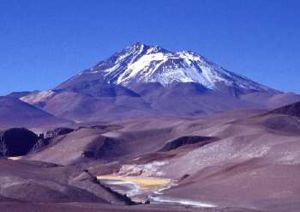Llullaillaco
| Llullaillaco | |
|---|---|
 Llullaillaco in 2006 |
|
| Elevation | 6,739 metres (22,110 ft) |
| Location | |
| Range | Andes, Puna de Atacama |
| Prominence | 2,344 metres (7,690 ft)[1] |
| Type | Stratovolcano |
| Age of rock | Pleistocene |
| Last eruption | 1877 |
| Listing | Ultra |

Llullaillaco is a stratovolcano at the border of Argentina (Salta Province) and Chile. It lies in the Puna de Atacama, a region of very high volcanic peaks on a high plateau within the Atacama Desert, one of the driest places in the world. Llullaillaco is the second highest active volcano in the world, surpassed only by Ojos del Salado. It is the fifth highest volcano in the world, and it is also the seventh highest mountain of the Western Hemisphere.[2]
Llullaillaco follows the typical Puna de Atacama volcano pattern: it is surrounded by large debris fields, and is perpetually capped by snow and small glaciers despite the extremely dry conditions of the region.
The peak's name comes from Aymara "murky water": llulla= dirty and yacu= water. Other sources propose it to have originated from Quechua Lullac= lie, Yacu= water: "lying (or treacherous) water".
It has been confirmed that Incas climbed Llullaillaco in the pre-Columbian period. Artifacts on the summit constitute the highest evidence of human presence worldwide before the late nineteenth century. Also, the huáqueros may have also reached its summit and those of other mountains in the region during their searches. The first recorded ascent was on December 1, 1952, by Bión González and Juan Harseim.
Contents |
Climbing routes
There are several climbing routes which do not require specialized climbing techniques, although the altitude imposes great difficulty and is by itself a very dangerous factor. Crampons and an ice axe are needed as most paths cross ice fields.
However, the area is known to be covered by antipersonnel mines installed during the Argentina-Chile conflict period of 1978-1982, thus rendering it extremely dangerous. Experienced local guidance and absolute caution is mandatory.
History
In 1999 on Llullaillaco's summit, an Argentine-Peruvian expedition directed by American archaeologist Dr. Johan Reinhard found the perfectly preserved bodies of three Inca children, sacrificed approximately 500 years ago. This is the highest Inca burial so far discovered in Tawantinsuyu and the world's highest archaeological site.
The mummies are those of a 15-year-old girl, nicknamed "La doncella" (The maiden), a seven-year-old boy, and a six-year-old girl, nicknamed "La niña del rayo" (The lightning girl). The latter's nickname reflects the fact that sometime in the 500 years period the mummy spent in the summit, it was struck by lightning, partially burning the preserved body, as well as some of the ceremonial artifacts left with the mummies.
The three mummies are exhibited at the Museo de Arqueología de Alta Montaña in Salta , Argentina, in a rotating fashion, so as not to expose any of the mummies for too long a time at once. Mummies are typically rotated in the exhibit every six months.[3]
Geology
Two major geological stages can be highlighted in the history of the volcano: Llullaillaco I, the ancestral primary volcano, dates back to the Pleistocene. Two very eroded cones with associated lava flows, up to 20 km in length, distributed mainly to the West, evidence these stages.
Built upon it there is a well preserved secondary post-glacial edifice called Llullaillaco II, which has been active during human history. Many Holocene lava flows are associated with this latter phase; the two most notable are directed North and South of the volcano. These youthful-looking dacitic flows have been dated to be of late Pleistocene age. Moreover, hot avalanche deposits, extending up to 3 km, are associated with one of the southern lava flows. There are still other very conspicuous flows remaining: one of the most striking, apparently caused by partial collapse of Lullaillaco I about 150,000 years ago, extends eastward into Argentina, diverging around Cerro Rosado stratovolcano 17 km to the East and terminating in the Salar del Llullaillaco. This deposit has not yet been thoroughly studied.
There are reports of eruptions in 1854, 1868, and 1877, possibly causing the youngest lava flows in the area, which are easily recognizable because of their very dark appearance.
See also
- List of volcanoes in Chile
- List of volcanoes in Argentina
References
- ↑ http://www.peakbagger.com/peak.aspx?pid=8545
- ↑ Andes 6000m peak list
- ↑ Grady, Denise (September 11, 2007). "In Argentina, a Museum Unveils a Long-Frozen Maiden", The New York Times. Retrieved on 2007-09-11.
- Siebert L, Simkin T (2002-). Volcanoes of the World: an Illustrated Catalog of Holocene Volcanoes and their Eruptions. Smithsonian Institution, Global Volcanism Program Digital Information Series, GVP-3, (http://www.volcano.si.edu/world/).
- Reinhard, Johan The Ice Maiden: Inca Mummies, Mountain Gods, and Sacred Sites in the Andes. 2005, Washington, D.C.: National Geographic Society.
- Reinhard, Johan y Constanza Ceruti. Investigaciones arqueológicas en el Volcán Llullaillaco: Complejo ceremonial incaico de alta montaña. Salta: EUCASA, 2000.
External links
- Brief geology and geochemistry descriptions. Includes a satellite photograph
- Expedition to the mountain. Several photographs
- Museum of High Mountain Archaeology (Spanish)
- Catholic University´s Institute of High Altitude Archaeology (Spanish)
- Llullaillaco on Summitpost
- [1] Llullayllaco Story (span.)
|
||||||||